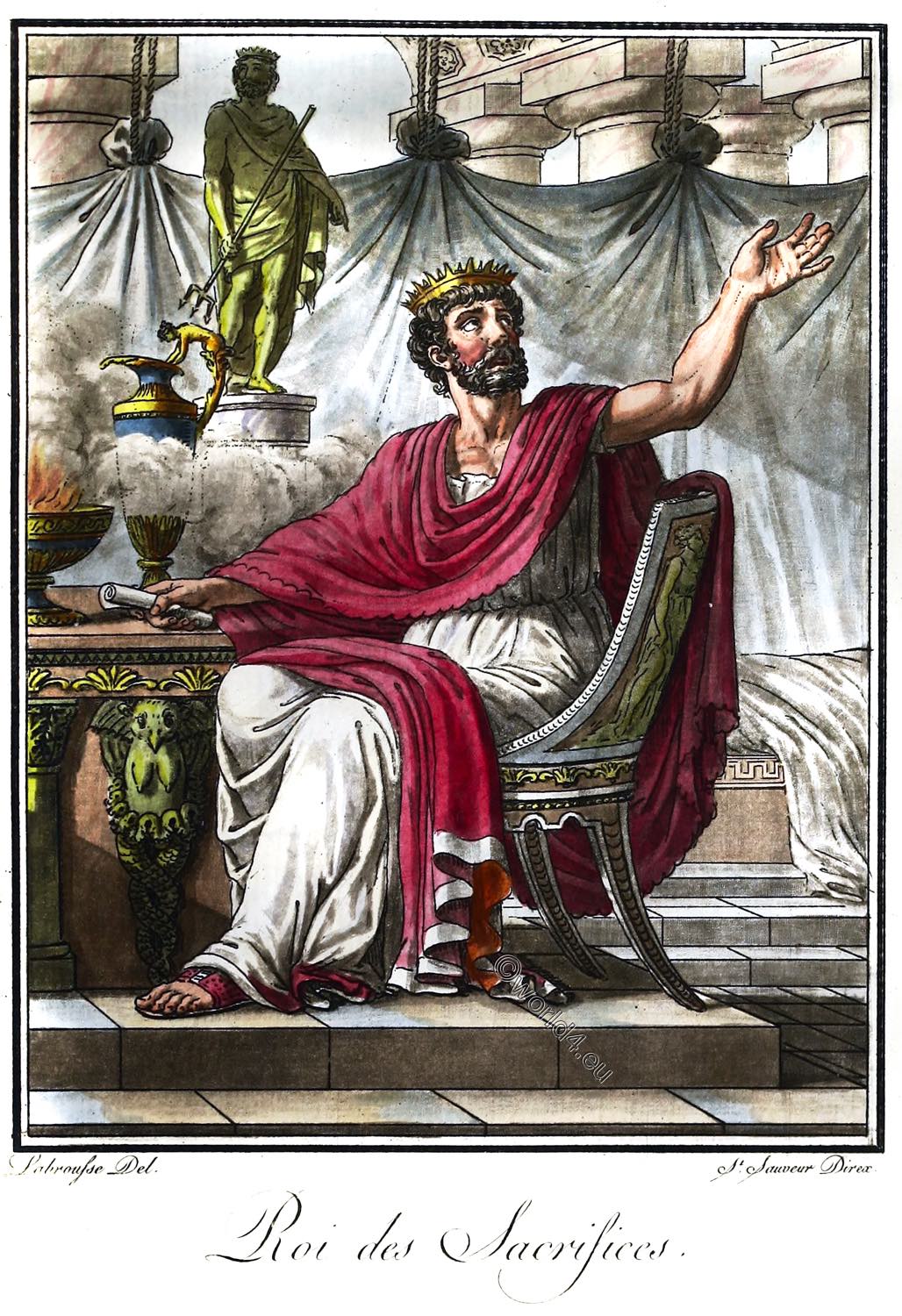Rex Sacrorum, the king of sacrifices.
The Rex Sacrorum (Latin “king for the sacred”), also known as Rex Sacrificulus was one of the highest Roman priests.
In February, the rex sacrorum and the Flamen Dialis jointly distributed the Februa, a cultic brushwood broom with which fields, meadows and houses were ritually cleaned at the beginning of field cultivation.
In the time of the Roman monarchy, it was the king who made the “great sacrifices”, his person being reputed to be the purest in the whole empire and the most pleasing to the gods.
The Romans constituted as a republic did not become less superstitious, because they attributed their prosperity to the care they took in their worship, they were afraid of displeasing heaven by no longer using the hand of a king for holy things: this is why they wanted to keep at least the word or the title by instituting a king of sacrifices; Rex Sacrorum.
The Rex Sacrorum belonged to the College of Pontifices and was directly subordinate to the Pontifex Maximus, although in the traditional cultic hierarchy it stood above the flamines maiores and the pontifex maximus.
Designated by the pontiffs and augurs, he was created by the people assembled in centuries, and always drawn from the order of the patricians, and from the names of the eldest; he was charged with doing exactly what the King once did in religion; he had no other office in the Republic and was free from all civil and military obligations. He had more or less the same privileges as the pontifices, but in contrast to these he was subject to several serious official restrictions. The most important was that he was not allowed to hold political office, which made the office not very desirable in the late Republic.
Source: L’antique Rome, ou, Description historique et pittoresque de tout ce qui concerne le peuple romain, dans ses costumes civiles, militaires et religieux, dans ses moeurs publiques et privées depuis Romulus jusqu’à Augustule: ouvrage orné de cinquante tableaux par Jacques Grasset de Saint-Sauveur. Paris: Chez Deroy, libraire, rue du Cimetière-André, no. 15, près la rue Haute-feuille, et chez les principaux libraires de la République 1796.

Continuing
- Roman Costume and Fashion History.
- Roman clothing in its diversity and development.
- The early toga. Former roman clothing. 700 BC. – 500 BC.
- The Toga and the manner of wearing it.
- The toga of a Roman senator. The armor of a Roman general.
- The costume of the Roman women. Republican Rome.
- The usual Roman garment during the Republican Rome.
- Roman Republic. Senator in the toga. A commoner in the paenula.
- The Togatus and the Roman ladies of the imperial period.
- The Roman Tunica or the Dorian and the Ionian chiton.
- Musical instruments. Wind and Stringed instruments of ancient Rome.
- Roman headgear and hairdos of antiquity.
- The Roman army. The legionary soldier. Equipment, assault weapons.
- Military of ancient Rome. Roman legions. Field signs. The legionary eagle.
- Roman soldiers and gladiators. Function, armor and armament.
- The Roman legionary. Reconstructed after reliefs of the Trajan’s Column.
- The Lictor panel. A stately Roman lictor in a rich costume.
- The Roman Paenula. The cowl or hood. Traveling cloak.
- Pontifex Maximus. Roman high priest of antiquity. Collegium Pontificum.
- An Augur. Roman official priesthood.
- The Rex Sacrorum also known as Rex Sacrificulus.
- Religious sacrificial ceremonies of Romans in ancient times.
- A quadriga. Greek-Roman Gods. The ancient greek-roman culture.
- The Clothing of the Vestal Virgins. The Cult of Vesta in ancient Rome.
- Shoes of antiquity. Sandals, closed footwear of the ancient world.
- The Etruscans. Culture, costumes, warriors in Etruria.
- Greek-Roman furniture. Throne chair, Bisellium, Sella castrensis.
- Greek-Roman art. Mosaics, painted bas-reliefs and wall paintings.
- A quadriga. Greek-Roman Gods. The ancient greek-roman culture.
- The Roman Ornament. Corinthian and Composite Capitals. The Acanthus.
- Rome. The atrium. Interior of an ancient Roman palace.
- Pompeji. Roman architecture. The Pompeian House. The Atrium.
- The Roman Pantheon, a temple to all the Gods.
- Britain under Roman rule. Celt and Roman. England 43 BC to 440 AD.
- Hadrians Wall. Roman Britain. Maps, Places, Tribes.
- The Gallic and Gallo-Roman costume period.
Discover more from World4 Costume Culture History
Subscribe to get the latest posts sent to your email.

